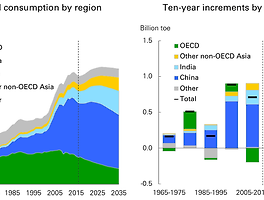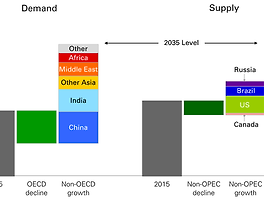bp-energy-outlook-2017 fuel by fuel detail Natural gas section입니다.
Strong growth in global gas supplies led by US shale supports increased consumption within industry and power
Increasing diversity of imported gas supplies supports gas consumption in key world markets
• Shale production (5.2% p.a.) accounts for around sixty percent of the increase in gas supplies, driven by the US where shale output more than doubles (43 Bcf/d).
Towards the end of the Outlook, China emerges as the second largest shale supplier. Shale gas accounts for around a quarter of total gas production by 2035.
• Increases in conventional gas production (0.7% p.a.) are led by the Middle East, Russia and Australia.
• The main centres of demand growth are: China, with gas gaining share in industry and power; and the Middle East and the US where increased availability of gas helps boost demand within the power sector.
• By sector, the largest contribution to consumption growth comes from the industrial sector (with combusted and non-combusted use together accounting for 45% of growth) followed by power (36%).
• 천연 가스는 석유와 석탄보다 빠르게 성장하며 1.6 % p.a 씩 성장합니다. 2015 년에서 2035 년 사이
• 셰일 생산량 (5.2 % p.a.)은 셰일 생산량이 두 배 이상인 미국 (43 Bcf / d)에 힘 입어 가스 공급 증가의 약 60 %를 차지합니다.
전망의 끝으로, 중국은 두 번째로 큰 셰일 공급자로 나타납니다. 셰일 가스는 2035 년까지 총 가스 생산량의 약 4 분의 1을 차지합니다.
• 기존 가스 생산량 (0.7 % p.a.)의 증가는 중동, 러시아 및 호주에 의해 주도됩니다.
• 수요 증가의 주요 센터는 다음과 같다. 중동 및 미주 지역에서는 가스의 가용성 증가로 인해 전력 부문의 수요가 증가 할 수 있습니다.
• 부문별로 소비 증가에 가장 큰 기여는 산업 부문 (연소 및 비 연소 사용이 함께 45 %의 성장을 차지함)과 그 다음으로 권력 (36 %)에 기인합니다.
Increasing diversity of imported gas supplies supports gas consumption in key world markets
• While import dependence grows in both China and Europe, the increased diversity of supplies associated with a rapid expansion of LNG helps to support gas consumption.
• In China, growth in gas consumption (5.4% p.a., 36 Bcf/d) outstrips domestic production, such that the share of imported gas in total consumption rises to nearly 40% by 2035, up from 30% in 2015.
• Around half of these increased imports are met by LNG, with rising pipeline imports from Russia and other Commonwealth of Independent States (CIS) countries providing the remainder.
• In Europe, domestic production is set to decline sharply (-3.2% p.a.) as existing fields mature and are not replaced. As a result, the share of imported gas in total consumption rises from around 50% in 2015 to nearly 80% by 2035.
• LNG imports are expected to supply around two-thirds of the increase in imports, with rising pipeline imports from Russia providing the remainder.
• 중국과 유럽 모두에서 수입 의존도가 증가하는 반면, LNG의 급속한 확장과 관련된 공급의 다양성 증가는 가스 소비를 지원하는 데 도움이됩니다.
• 중국에서는 가스 소비 증가 (5.4 % p.a., 36 Bcf / d)가 국내 생산보다 많아 2015 년까지 총 소비에서 차지하는 수입 가스의 비중이 2015 년 30 %에서 40 %로 증가합니다.
• 이러한 증가 된 수입량의 약 절반이 LNG에 의해 충족되며 러시아 및 기타 CIS (Commonwealth of Independent States) 국가로부터 파이프 라인 수입이 증가하여 나머지를 제공합니다.
• 유럽의 경우 기존 생산이 성숙되어 대체되지 않아 국내 생산이 급격하게 감소 (-3.2 % p.a.) 할 것으로 예상됩니다. 결과적으로, 총 소비에서 차지하는 수입 가스의 비중은 2015 년 약 50 %에서 2035 년 80 % 가까이 증가합니다.
• LNG 수입은 수입 증가의 약 3 분의 2를 공급할 것으로 예상되며 러시아로부터 파이프 라인 수입이 증가하면서 나머지 수입이 증가 할 것으로 예상됩니다.
[재테크] - BP 2017 에너지전망(+ Welcome to the 2017 edition of BP’s Energy Outlook)
[재테크] - BP 2017 에너지전망(+ Base case: Primary energy)
[재테크] - BP 2017 에너지전망(+ oil fuel by fuel detail)
[재테크] - BP 2017 에너지전망(+ Natural gas fuel by fuel detail)
[재테크] - BP 2017 에너지전망(+ key issue)
[재테크] - BP 2017 에너지전망(+ Main revision)
[재테크] - BP 2017 에너지전망(+ Key uncertainties)
[재테크] - BP 2017 에너지전망(+ Beyond 2035)
[재테크] - BP 2017 에너지전망(+ Annex)
'Energy' 카테고리의 다른 글
| BP 2017 에너지전망(+ Main revision) (0) | 2018.02.07 |
|---|---|
| BP 2017 에너지전망(+ key issue) (0) | 2018.02.06 |
| BP 2017 에너지전망(+ Coal, Nuclear and hydro, Renewables) (0) | 2018.02.04 |
| BP 2017 에너지전망(+ oil fuel by fuel detail) (0) | 2018.02.04 |
| BP 2017 에너지전망(+ Base case: Primary energy) (0) | 2018.02.03 |





